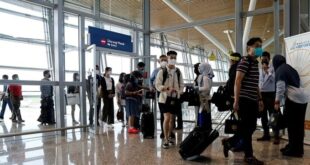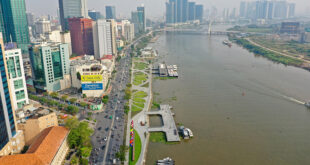Tour guides who specialize in serving inbound tourists have seen some light at the end of the tunnel with the government announcing full tourism reopening next month.
Several challenges still await, but the feeling of relief is palpable.
JP Klovstad, a Norwegian who works as a tour guide for Albatros Travel, a Danish company specializing in bringing Norwegian tourists to Vietnam and Southeast Asia, told VnExpress International he was very happy to hear that the borders would reopen soon.
“Many in Norway and the rest of the world are ready to travel. It will be great for hotels, restaurants in Vietnam to get tourists back,” said the 60-year-old resident of HCMC’s Thu Duc City.
The government has agreed to reopen inbound and outbound tourism from March 15 under new normal conditions, with foreign tourists allowed to travel freely to Vietnam without booking tour packages as had been mandated so far in the reopening process.
Klovstad said he’d been waiting for this moment for a long time, having struggled for the past two years after Vietnam closed inbound tourism due to the Covid-19 pandemic.
“The hardest thing is not to have an income and not know when I will be able to work next. Also, I had to find a way to be able to get around a bit without using too much money,” he said.
Nguyen Minh Truong, who used to work as a tour guide for HCMC-based company and has 14 years of experience in serving inbound tourists, said he felt he was being revived after two years of struggling with other side jobs to make a living.
“It was really a nightmare after Vietnam closed inbound tourism. From a tour guide with a monthly income of over VND20 million ($875), I had to switch to being a food delivery person earning around VND7 million a month.”
“I missed my job and customers and I have never experienced such a long break,” said Truong, adding, “tourism workers like me will get out of a nightmare when Vietnam fully reopens international tourism.”
Worries remain
Accompanying the feelings of happiness and relief at the news of a full reopening is a sense of uncertainty about career prospects.
Klovstad said he had to be patient and wait for tourist groups to come in the second half of 2022 because foreign tourists need several months to plan their trips.
“I am afraid we must wait until September or October before the group of tourists come back for the peak travel season,” he said.
“As soon as I am told a group is on its way, I am ready to go, Hanoi to Saigon, Bangkok to Saigon or any other tour I am asked to run,” he added.
“I get a lot of comments online from my former guests asking when Vietnam and Southeast Asian countries will reopen their borders and when I can run my tours again. So, for sure, people in Norway are ready to go on tour again.”
Truong said the number of foreign tourists visiting Vietnam during the first phase of full tourism reopening will be low as they still need more time to see Vietnam’s entry and tourism policies before deciding whether to visit or revisit the country or not.
He said that even after returning to his earlier job as a tour guide, he would continue with his side job to ensure a source of income.
Ly Truong Thanh, a 32-year-old freelance tour guide in HCMC who mainly serves groups of Chinese tourists, Vietnam’s biggest feeder market, said he was facing an uncertain future because China was still pursuing a zero-Covid policy and maintaining one of the world’s strictest entry restrictions.
“Currently, I still live on my side job as a Chinese language interpreter. If China still restricts its citizens from traveling abroad, I will switch to serving outbound tourists, but I need a little time to improve my knowledge and other skills,” Thanh said.
The Covid-19 pandemic has taken a heavy toll on the tourism industry, which accounted for about 10 percent of gross domestic product in 2019, the year before the onset of the pandemic.
According to a report by the Ministry of Culture, Sports and Tourism, tourism businesses cut staff by 70-80 percent in 2020. In 2021, full-time tourism employees only accounted for 25 percent of the number in 2020 and about 30 percent quit or had their contracts terminated.
Before the Covid-19 pandemic, over 26,000 tour guides were licensed to operate in the country, including 16,000 specializing in outbound tours, according to official data.
- Reduce Hair Loss with PURA D’OR Gold Label Shampoo
- Castor Oil Has Made a “Huge” Difference With Hair and Brow Growth
- Excessive hair loss in men: Signs of illness that cannot be subjective
- Dịch Vụ SEO Website ở Los Angeles, CA: đưa trang web doanh nghiệp bạn lên top Google
- Nails Salon Sierra Madre
 VnExpress News The News Gateway of Vietnam
VnExpress News The News Gateway of Vietnam



